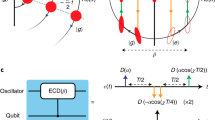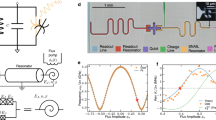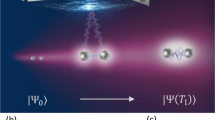Abstract
Quantum computation presents a powerful new paradigm for information processing. A robust universal quantum computer can be realized with any well controlled quantum system, but a successful platform will ultimately require the combination of highly coherent, error-correctable quantum elements with at least one entangling operation between them1,2. Quantum information stored in a continuous-variable system—for example, a harmonic oscillator—can take advantage of hardware-efficient quantum error correction protocols that encode information in the large available Hilbert space of each element3,4,5. However, such encoded states typically have no controllable direct couplings, making deterministic entangling operations between them particularly challenging. Here we develop an efficient implementation of the exponential-SWAP operation6 and present its experimental realization between bosonic qubits stored in two superconducting microwave cavities. This engineered operation is analogous to the exchange interaction between discrete spin systems, but acts within any encoded subspace of the continuous-variable modes. Based on a control rotation, the operation produces a coherent superposition of identity and SWAP operations between arbitrary states of two harmonic oscillator modes and can be used to enact a deterministic entangling gate within quantum error correction codes. These results provide a valuable building block for universal quantum computation using bosonic modes.
This is a preview of subscription content, access via your institution
Access options
Access Nature and 54 other Nature Portfolio journals
Get Nature+, our best-value online-access subscription
$29.99 / 30 days
cancel any time
Subscribe to this journal
Receive 51 print issues and online access
$199.00 per year
only $3.90 per issue
Buy this article
- Purchase on Springer Link
- Instant access to full article PDF
Prices may be subject to local taxes which are calculated during checkout




Similar content being viewed by others
Data availability
The data that support the findings of this study are available from the corresponding authors on reasonable request.
References
DiVincenzo, D. P. The physical implementation of quantum computation. Fortschr. Phys. 48, 771–783 (2000).
Nielsen, M. A. & Chuang, I. L. Quantum Computation and Quantum Information (Cambridge Univ. Press, Cambridge, 2000).
Chuang, I. L., Leung, D. W. & Yamamoto, Y. Bosonic quantum codes for amplitude damping. Phys. Rev. A 56, 1114–1125 (1997).
Gottesman, D., Kitaev, A. & Preskill, J. Encoding a qubit in an oscillator. Phys. Rev. A 64, 012310 (2001).
Sanders, B. C., Bartlett, S. D. & de Guise, H. From qubits to continuous-variable quantum computation. Preprint at http://arXiv.org/abs/quant-ph/0208008v1 (2002).
Lau, H.-K. & Plenio, M. B. Universal quantum computing with arbitrary continuous-variable encoding. Phys. Rev. Lett. 117, 100501 (2016).
Reagor, M. et al. Quantum memory with millisecond coherence in circuit QED. Phys. Rev. B 94, 014506 (2016).
Heeres, R. W. et al. Implementing a universal gate set on a logical qubit encoded in an oscillator. Nat. Commun. 8, 94 (2017).
Ofek, N. et al. Extending the lifetime of a quantum bit with error correction in superconducting circuits. Nature 536, 441–445 (2016).
Menicucci, N. C. et al. Universal quantum computation with continuous-variable cluster states. Phys. Rev. Lett. 97, 110501 (2006).
Mirrahimi, M. et al. Dynamically protected cat-qubits: a new paradigm for universal quantum computation. New J. Phys. 16, 045014 (2014).
Michael, M. H. et al. New class of quantum error-correcting codes for a bosonic mode. Phys. Rev. X 6, 031006 (2016).
Albert, V. V. et al. Performance and structure of single-mode bosonic codes. Phys. Rev. A 97, 032346 (2018).
Rosenblum, S. et al. A CNOT gate between multiphoton qubits encoded in two cavities. Nat. Commun. 9, 652 (2018).
Chou, K. S. et al. Deterministic teleportation of a quantum gate between two logical qubits. Nature 561, 368–373 (2018).
Milburn, G. J. Quantum optical Fredkin gate. Phys. Rev. Lett. 62, 2124 (1989).
Filip, R. Overlap and entanglement-witness measurements. Phys. Rev. A 65, 062320 (2002).
Petta, J. R. et al. Coherent manipulation of coupled electron spins in semiconductor quantum dots. Science 309, 2180–2184 (2005).
Anderlini, M. et al. Controlled exchange interaction between pairs of neutral atoms in an optical lattice. Nature 448, 452–456 (2007).
Kaufman, A. M. et al. Entangling two transportable neutral atoms via local spin exchange. Nature 527, 208–211 (2015).
DiVincenzo, D. P., Bacon, D., Kempe, J., Burkard, G. & Whaley, K. B. Universal quantum computation with the exchange interaction. Nature 408, 339–342 (2000).
Kempe, J., Bacon, D., Lidar, D. A. & Whaley, K. B. Theory of decoherence-free fault-tolerant universal quantum computation. Phys. Rev. A 63, 042307 (2001).
Sun, L. et al. Tracking photon jumps with repeated quantum non-demolition parity measurements. Nature 511, 444–448 (2014).
Wang, C. et al. A Schrödinger cat living in two boxes. Science 352, 1087–1091 (2016).
Gao, Y. Y. et al. Programmable interference between two microwave quantum memories. Phys. Rev. X 8, 021073 (2018).
Patel, R. B., Ho, J., Ferreyrol, F., Ralph, T. C. & Pryde, G. J. A quantum Fredkin gate. Sci. Adv. 2, e1501531 (2016).
Ono, T., Okamoto, R., Tanida, M., Hofmann, H. F. & Takeuchi, S. Implementation of a quantum controlled-SWAP gate with photonic circuits. Sci. Rep. 7, 45353 (2017).
Flammia, S. T. & Liu, Y.-K. Direct fidelity estimation from few Pauli measurements. Phys. Rev. Lett. 106, 230501 (2011).
Chow, J. M. et al. Universal quantum gate set approaching fault-tolerant thresholds with superconducting qubits. Phys. Rev. Lett. 109, 060501 (2012).
Lloyd, S., Mohseni, M. & Rebentrost, P. Quantum principal component analysis. Nat. Phys. 10, 631–633 (2014).
Lau, H.-K., Pooser, R., Siopsis, G. & Weedbrook, C. Quantum machine learning over infinite dimensions. Phys. Rev. Lett. 118, 080501 (2017).
Axline, C. et al. An architecture for integrating planar and 3D cQED devices. Appl. Phys. Lett. 109, 042601 (2016).
Gong, Y.-X., Guo, G.-C. & Ralph, T. C. Methods for a linear optical quantum Fredkin gate. Phys. Rev. A 78, 012305 (2008).
Fiurášek, J., Dušek, M. & Filip, R. Universal measurement apparatus controlled by quantum software. Phys. Rev. Lett. 89, 190401 (2002).
Vlastakis, B. M. et al. Characterizing entanglement of an artificial atom and a cavity cat state with Bell’s inequality. Nat. Commun. 6, 8970 (2015).
Lanyon, B. P. et al. Experimental demonstration of a compiled version of Shor’s algorithm with quantum entanglement. Phys. Rev. Lett. 99, 250505 (2007).
Ekert, A. K. et al. Direct estimations of linear and nonlinear functionals of a quantum state. Phys. Rev. Lett. 88, 217901 (2002).
Chuang, I. L. & Nielsen, M. A. Prescription for experimental determination of the dynamics of a quantum black box. J. Mod. Opt. 44, 2455–2467 (1997).
Hu, L. et al. Demonstration of quantum error correction and universal gate set on a binomial bosonic logical qubit. Preprint at http://arXiv.org/abs/1805.09072 (2018).
Flühmann, C. et al. Encoding a qubit in a trapped-ion mechanical oscillator. Nature https://doi.org (2018).please provide doi of linked Phys Lett when known.
Lähteenmäki, P., Paraoanu, G. S., Hassel, J. & Hakonen, P. J. Coherence and multimode correlations from vacuum fluctuations in a microwave superconducting cavity. Nat. Commun. 7, 12548 (2016).
Pierre, M., Sathyamoorthy, S. R., Svensson, I., Johansson, G. & Delsing, P. Resonant and off resonant microwave signal manipulations in coupled superconducting resonators. Preprint at http://arXiv.org/abs/1802.09034 (2018).
Sandbo Chang, C. W. et al. Generating multimode entangled microwaves with a superconducting parametric cavity. Phys. Rev. Appl. 10, 044019 (2018).
Acknowledgements
We thank R. Filip for helpful discussions; N. Frattini, K. Sliwa, M. J. Hatridge and A. Narla for providing the Josephson parametric converters; and N. Ofek and P. Reinhold for providing the logic and control interface for the field programmable gate array used in this experiment. This research was supported by the US Army Research Office (W911NF-14-1-0011 and W911NF-16-10349). Y.Y.G. was supported by an A∗STAR NSS Fellowship; B.J.L. was supported by a Yale QIMP Fellowship; S.M.G. was supported by the National Science Foundation (DMR-1609326); and L.J. was supported by the Alfred P. Sloan Foundation (BR 2013-049) and the Packard Foundation (2013-39273). Facilities use was supported by the Yale Institute for Nanoscience and Quantum Engineering (YINQE), the Yale SEAS cleanroom, and the National Science Foundation (MRSECDMR-1119826).
Reviewer information
Nature thanks Kero Lau and Gheorghe Paraoanu for their contribution to the peer review of this work.
Author information
Authors and Affiliations
Contributions
Y.Y.G. and B.J.L. fabricated the transmon qubits, assembled the experimental apparatus, and performed the experiments under the supervision of L.F., M.H.D. and R.J.S. Y.Y.G., B.J.L. and K.S.C. analysed the data. L.J. and S.M.G. provided theoretical support. Y.Y.G., B.J.L. and R.J.S. wrote the manuscript with feedback from all authors.
Corresponding authors
Ethics declarations
Competing interests
R.J.S., M.H.D. and L.F. are co-founders of, and R.J.S. and L.F. are equity shareholders in, Quantum Circuits, Inc. Y.Y.G., B.J.L., L.J., S.M.G. and R.J.S. are inventors on patent application no. 62/613,866 submitted by Yale University, which covers the design and methods for Robust Quantum Logical Gates.
Additional information
Publisher’s note: Springer Nature remains neutral with regard to jurisdictional claims in published maps and institutional affiliations.
Extended data figures and tables
Extended Data Fig. 1 Top view of the 3D double-cavity cQED system.
The centre transmon ancilla (qC) provides nonlinear coupling between the modes of Alice (orange) and Bob (blue). The package accommodates two additional transmon ancillae, qA and qB, which are each coupled to one of the cavities Alice and Bob, respectively. Each transmon ancilla is measured via a neighbouring readout resonator (RA, RB, RC). The RF drives (ω1, ω2) are coupled to the system through the drive port of qC. See Methods for details.
Extended Data Fig. 2 A quantum Fredkin gate.
a, The resonance condition for a parametrically driven SWAP operation measured as a function of one of the drive frequencies and the drive duration with the ancillary transmon initialized in \((|g\rangle +|e\rangle )/\sqrt{2}\). The colour scale shows the probability for the ancilla to be excited (Pe) after a rotation that follows the parametric drive. b, The reconstructed three-mode density matrix after the Fredkin gate for the initial states \(\left|g\right\rangle \otimes \left|0\right\rangle \otimes \left|1\right\rangle \)(upper left), \(\left|e\right\rangle \otimes \left|0\right\rangle \otimes \left|1\right\rangle \)(upper right), \(\frac{1}{\sqrt{2}}\left(\left|g\right\rangle +\left|e\right\rangle \right)\otimes \left|0\right\rangle \otimes \left|1\right\rangle \)(bottom left) and \(\frac{1}{\sqrt{2}}\left(\left|g\right\rangle -\left|e\right\rangle \right)\otimes \left|0\right\rangle \otimes \left|1\right\rangle \)(bottom right). The colour scale shows the real value of each element in the reconstructed density matrices.
Extended Data Fig. 3 The quantum process matrix for Fock encoding.
The real (left) and imaginary (right) components of the complex process matrix χ are shown for the input (a), the identity operation (b), \(\sqrt{\mathrm{SWAP}}\) (c) and SWAP (d). For each operation, we show the measured (top) and ideal (bottom) matrices for comparison. Each of the measured process matrices are calculated without correction for SPAM errors. The colour scale shows the value for each (real or imaginary) component of the respective process matrices.
Extended Data Fig. 4 QPT for binomial code.
Left to right: the process matrix in the Pauli transfer representation for \({U}_{{\rm{E}}}\left(0\right)\), \({U}_{{\rm{E}}}({\rm{\pi }}/4)\) and \({U}_{{\rm{E}}}({\rm{\pi }}/2)\) acting on Alice and Bob, encoded in the binomial basis. From these results, we obtain a process fidelity of 0.70, 0.58 and 0.65 for the three operations without correction for SPAM errors. The colour scale shows the value for each element of the respective process matrices.
Supplementary information
Supplementary Information
This file contains Supplementary Text with additional details about the operation and an error budget, as well as additional references, Supplementary Figures 1-2 and Supplementary Tables 1-2
Rights and permissions
About this article
Cite this article
Gao, Y.Y., Lester, B.J., Chou, K.S. et al. Entanglement of bosonic modes through an engineered exchange interaction. Nature 566, 509–512 (2019). https://doi.org/10.1038/s41586-019-0970-4
Received:
Accepted:
Published:
Issue Date:
DOI: https://doi.org/10.1038/s41586-019-0970-4
This article is cited by
-
Engineering multimode interactions in circuit quantum acoustodynamics
Nature Physics (2024)
-
High-fidelity parametric beamsplitting with a parity-protected converter
Nature Communications (2023)
-
Resolving Fock states near the Kerr-free point of a superconducting resonator
npj Quantum Information (2023)
-
Parity measurement in the strong dispersive regime of circuit quantum acoustodynamics
Nature Physics (2022)
-
Multimode photon blockade
Nature Physics (2022)
Comments
By submitting a comment you agree to abide by our Terms and Community Guidelines. If you find something abusive or that does not comply with our terms or guidelines please flag it as inappropriate.



